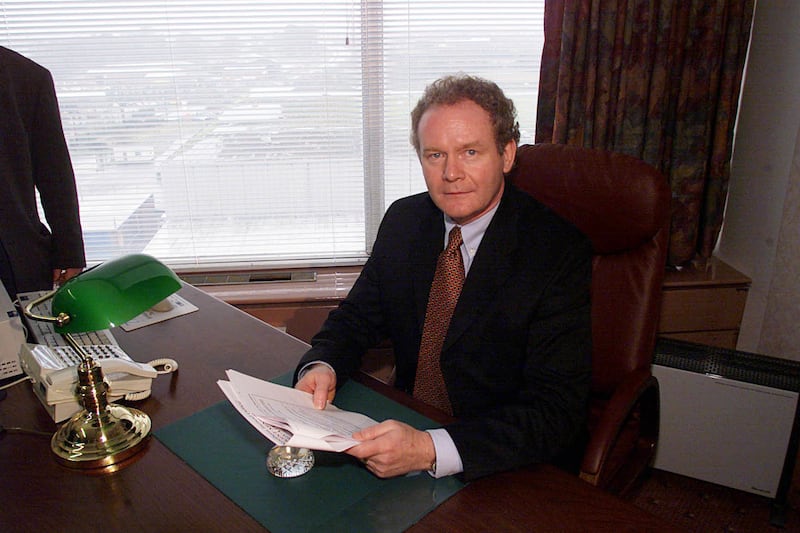“There are more things in life than killing,” Freddie Scappaticci, code-named Stakeknife, once said when asked why he claimed to have stood down as an IRA activist.
It is clear from the 208-page Operation Kenova report that in his many years as a senior IRA figure and British army agent that Scappaticci’s life was dominated by that very act: killing.
He was a killer for the IRA and, on reading the Kenova report, who can deny that he was a killer for the British army and by extension the British state.
Months in advance of the report’s publication, one legal source predicted its findings would be embarrassing for the British army, MI5, the UK’s domestic intelligence agency, and the British government, and also for the IRA, and by association for Sinn Féin, but that no one would be made criminally accountable.
READ MORE
“The men in dark suits in Whitehall and the men in dark balaclavas in west Belfast won’t be made to pay,” he said.
And he was right.
[ Stakeknife: The inside story of IRA double agent Freddie ScappaticciOpens in new window ]
In the past couple of months the North’s director of public prosecutions said that in consideration of several files received from the Kenova team relating to 32 former British soldiers and IRA members there was “no reasonable prospect of convictions” or “insufficient evidence” to press charges over Stakeknife’s operations.
It says a lot about the nature of Northern Ireland’s “dirty war” that the absence of prosecutions has caused little surprise.
But if there is no justice at least Kenova has produced more truth about the clandestine battle waged between the British intelligence services and the IRA during the Troubles while offering just a few more insights into the strange and murderous nature of Belfast man Freddie Scappaticci.
The report does not name Scappaticci as Stakeknife because of the “neither confirm nor deny” British security policy over agents but, as said by solicitor Kevin Winters, acting for a number of families bereaved by the IRA, the “dogs in the street” know Scappaticci was Stakeknife. Boutcher himself said on Friday that this stricture was no longer “tenable”.
But the report is sharp and precise in dismissing the claim that he saved “hundreds and hundreds of lives”, as was stated by the former British army commander in Northern Ireland, the late General Sir John Wilsey who also described him as the “golden egg” – “the jewel in the crown” of British military intelligence.
Kenova’s interim report says: “The claims are inherently implausible and should ring alarm bells: any serious security and intelligence professional hearing an agent being likened to ‘the goose that laid the golden eggs’ – as Stakeknife was – should be on the alert because the comparison is rooted in fables and fairy tales.”
The “hundreds and hundreds of lives” claims, Kenova added, derived from assessments by the British army Force Research Unit (FRU), who ran Scappaticci, “which were based on unreliable and internal speculative metrics”.
So, did he do any good? Kenova concluded that the “number of identifiable individuals whose lives were saved in reliance on his information ... is between high single figures and low double figures”.
And here the report caveats that this “net estimate” does not “take account of the lives lost as a consequence of Stakeknife’s continued operation as an agent”.
And then Boutcher and Iain Livingstone, who took over as the new lead of Kenova last year after Boutcher became the PSNI’s interim chief constable, added possibly the strongest line of the report, “From what I have seen I think it probable that this resulted in more lives being lost than saved.”
“Furthermore, there were undoubtedly occasions when Stakeknife ignored his handlers, acted outside his taskings and did things he should not have done and when very serious risks were run”.
These lines support the brutal contention that whatever about his protestations about tiring of killing he was a killer for the IRA and British army intelligence.
This contention is further sustained by the more general line in Kenova that RUC “special branch and the FRU withheld information from and about their agents in order to protect them from compromise and withdrawal with the result that very serious criminal offences, including murder, were not prevented or investigated when they could and should have been”.
And neither does Kenova mince its words in relation to putting the moral rule over Stakeknife and the IRA and British intelligence.
“In the context of our Kenova investigations, PIRA’s [Provisional IRA] actions were the most shameful and evil I have encountered. It was the PIRA leadership that commissioned and sanctioned the activities its ISU [internal security unit] carried out. It was PIRA that committed the brutal acts of torture and murder, each evil act being the epitome of cowardice,” says the report.
For the British security forces, it said: “Too often they did not act on information and people who had a legal right and expectation of protection were abandoned to PIRA.”
And it added: “It is a core responsibility of government to protect its citizens. When those who assist the security forces do this by putting their own lives at risk the government has a moral responsibility and legal duty to protect them. When such agents are let down and abandoned to their fate we must acknowledge this, apologise and learn any lessons.
“It is one thing to have been unable to protect every person, including agents, in every situation because of the extremely dangerous environment, volume of incidents and chaotic times. It is entirely another to deliberately not apply the rule of law and to allow people come to serious harm and be murdered.”
Freddie Scappaticci was a hardman who was feared by most of his IRA comrades. Earlier this week the BBC released some previously unseen footage of him when in 2003 he was secretly filmed at his home.
“Don’t take any more photos of this house I am telling you now because if you do I will come out and I will f**king do you,” he shouted at a cameraman.
In Scappaticci’s world, that would not have passed as an idle threat. During one interrogation in west Belfast he told suspected informer Sandy Lynch that if he did not confess he would “get a jab up the arse” and wake up in south Armagh hanging upside down in a cattle shed where no one could hear his screams.
No wonder that IRA members, even if totally innocent of suspicions of “touting”, would be happier to face an RUC special branch questioning or court hearing than be called before the Nutting Squad.
There are a number of theories as to why Scappaticci became an informer in 1978 but no one has definitively answered this, and neither does the Kenova report provide an explanation. It was said that he was badly beaten in a row with another IRA member and “turning tout” was a way of exacting revenge.
The reported £80,000 a year he received could have been a factor. It was speculated that an interest in hard-core pornography could have left him open to blackmail but while late in his life he was convicted of possessing such material that hardly stands up. He was described as a “walk-in” – someone who volunteered to work for British intelligence; he didn’t have to be blackmailed or bribed, though he did take the money on offer.
It was 1993 when Scappaticci told reporters for ITV’s investigative Cook Report that “there are more things in life than killing”. While ultimately no one can determine the inner nature of any person, it seems unlikely that this comment was prompted by contrition or a newfound sympathy for his victims.
But he seemed to harbour some demons about his work, and also grudges, one of the most bitter of which was against the late Sinn Féin leader Martin McGuinness, who is also named in the Kenova report as a “PIRA leader”. Astonishingly, he volunteered to speak to the Cook Report reporters after the broadcast of a programme focused on the IRA activities of McGuinness.

He gave two interviews which were secretly recorded and broadcast, arriving in his own car which the Cook Report pretty easily established belonged to Scappaticci, although his name was not disclosed.
It seemed the height of recklessness, an act if discovered by the IRA that would have brought him in front of his own security unit. But Scappaticci was brass-necked, possibly believing that having successfully led a double life that he could brazen out anything republican leaders might throw at him.
He felt the programme had not dug deep enough into McGuinness’s activities and under an assumed name offered to provide more detail.
He described McGuinness as “ruthless”, a “very cold person”, an “evil man” who “one minute would be in church and the next would say, ‘stiff him’” about one of his alleged victims. He also brought the interview around to his own “Nutting Squad”, saying that McGuinness had “the final say on an informer, whether that person lives of dies”.
But if that interview somehow suggests he had reservations or even feelings of guilt about how he dealt with alleged informers, other stories point in a different direction. It’s worth repeating how former IRA man Eamon Collins, who himself was murdered by the south Armagh IRA, worked for a period with Scappaticci in the internal security unit.

The brutal crimes of IRA double agent Freddie Scappaticci
Hosted by Bernice Harrison. Guests Gerry Moriarty and Kevin Winters. This episode was originally published in April 2023.
In his book Killing Rage, Collins recounted how he had asked Scappaticci, whom he called “Scap”, and John Joe Magee, then head of the unit, whether victims were told they were about to be killed.
Collins wrote about one man who confessed after being offered an amnesty and how he thought he was being driven back to his home. The man was blindfolded as he was taken out of their car.
“It was funny,” Scappaticci told Collins, “watching the bastard stumbling and falling, asking me as he felt his way along the railings and walls, ‘Is this my house now?’ and I’d say, ‘No, not yet, walk on some more ... ' ' ... and then you shot the f**ker in the back of the head,’ said John Joe, and both of them burst out laughing.”
Scappaticci told the Cook Report in 1993 that he was no longer an IRA member and while that was false, it appeared that he stood down or was stood down a few years later.
When he was exposed in 2003 Scappaticci at first felt confident enough to deny all claims against him, giving an interview in the presence of his solicitor and also speaking to the Andersonstown News, the local west Belfast newspaper. But while he was brazen, he wasn’t stupid. Seeing the odds stacked against him he eventually went into a witness protection programme somewhere, it is believed, in England.
In later years it seems some of his cockiness was overtaken by depression and that his final days were rather unhappy and ignominious, points underlined by how in 2018 he was convicted of possessing extreme pornography including images of bestiality.
This was an interim report. More light was shed by Kenova, which might provide some release for the victims’ families.
The final report, whenever it comes, said Kenova’s chief Sir Iain Livingstone, will “tell the full story”.
- Listen to our Inside Politics Podcast for the latest analysis and chat
- Sign up for push alerts and have the best news, analysis and comment delivered directly to your phone
- Find The Irish Times on WhatsApp and stay up to date



















